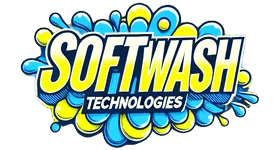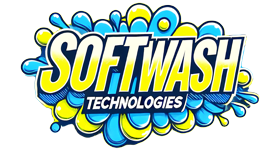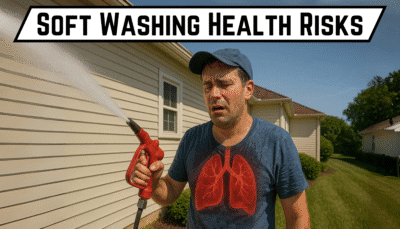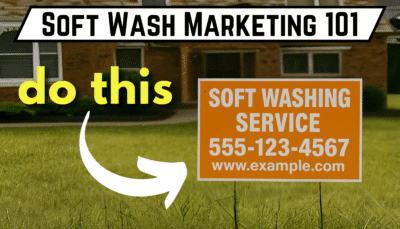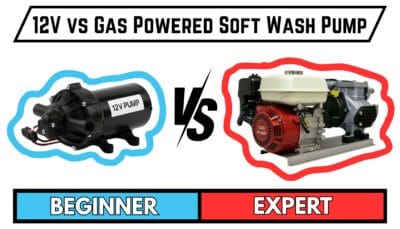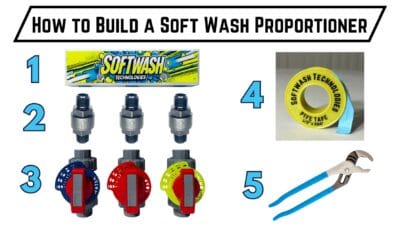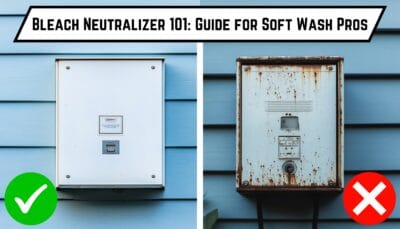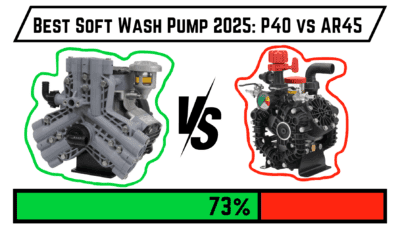Bleach neutralizer is one of the most under-utilized and misunderstood tools in the soft washing industry. In this article you will learn what a neutralizer is, why it’s an important part of safe soft washing, and how to educate and charge your customers properly for increased protection.
Introduction to Bleach Neutralizers in Soft Washing
Why Neutralizing Bleach Matters
Soft washing is an effective method for cleaning delicate surfaces like roofs, siding, and decks using a low-pressure water system combined with sodium hypochlorite (also known as SH or bleach). While bleach is excellent at breaking down organic matter like mold, algae, and mildew, it doesn’t stop working once the surface is clean. If left unchecked, residual bleach can continue reacting with surfaces, causing discoloration or degradation, and worse, it can leach into soil, damaging landscaping and harming the environment.
This is where bleach neutralizers come into play. These products halt the chemical activity of bleach, making the soft washing process not only safer but more responsible.

What Is a Bleach Neutralizer?
A bleach neutralizer is a chemical solution that reacts with and deactivates residual SH. It stops bleach from continuing its reactions, making surfaces and runoff safer post-treatment.
SH is highly alkaline (pH 11 to 13) and a neutralizer helps bring that pH closer to neutral (pH 7). Some bleach neutralizers are infused with a surfactant which reduces surface tension and helps your neutralizer penetrate deeper, just like the surfactant in your soft wash mix.
Common Misconceptions About Bleach Residue
Many professionals mistakenly believe rinsing with water is enough to eliminate bleach. While dilution reduces potency, it doesn’t fully deactivate the chemical.
That said, bleach neutralizers are designed to eliminate these risks. A good neutralizer is easy to use, cost-effective, and built for the high SH percentages used in soft washing.
Introducing NeutraPods
NeutraPods is our favorite bleach neutralizer for several reasons:
- Most concentrated neutralizer on the market: NeutraPods can handle all soft wash mix concentrations from 1% to 13%+, while competitors are often rated for less than 2% SH.
- Easy to use: Each pod is a water-soluble pouch, about the size of a baseball. Drop them into a gutter or downspout to neutralize roof runoff before it hits the ground. You can also place them in a water tank to premix your neutralizer.
- Cost effective: Since NeutraPods is the most concentrated neutralizer available, you can neutralize more SH by volume than any other product.
- Infused with surfactant: NeutraPods contain a surfactant that reduces surface tension and boosts the penetration of your neutralizer.
Unlike other bleach neutralizers, NeutraPods are shipped in a solid state with no liquid added. Why pay to ship water when you don’t have to?

When and Why to Use a Bleach Neutralizer
Protecting Plants, Pets, and Surfaces
Bleach runoff can burn leaves and cause browning or die-off. Pets exposed to SH can suffer skin irritation or poisoning if ingested. Surfaces like untreated wood, pavers, and anodized metals can fade or corrode. Using a bleach neutralizer like NeutraPods eliminates these risks. It creates a professional finish your clients will appreciate.
How Using a Neutralizer Protects Your Business
I heard a story of a guy who soft washed a barrel tile roof with iron nails securing the tiles. He was new to the industry and had never even heard of a bleach neutralizer. A couple weeks later he got a call from his client who reported the tiles had started sliding off the roof. According to the insurance company he was found liable and negligent for failing to properly post treat the roof, thus corroding the iron nails resulting in loose tiles.
Don’t let this be you…
SH damage isn’t always immediate. Many surfaces around the house have a protective coating that prevents oxidation and corrosion. Eventually, if SH is allowed to sit on these surfaces untreated, it can open up the material to weathering, UV, and corrosion down the road.

How to Communicate the Value of Neutralization
Educating customers about bleach neutralization is a great opportunity to build trust. Explain that bleach continues to react after cleaning and can damage their landscaping, surfaces, or pets if not neutralized. Let them know that you’re using NeutraPods, a product proven to safely deactivate bleach and protect their property.
Use simple, benefit-focused language such as: “We include a neutralizer treatment at the end of each job to protect your home and landscaping. It’s an extra layer of safety that prevents plant damage and surface wear from leftover bleach.”
Incorporating Neutralizer Costs Into Estimates
There are two main approaches to pricing:
- Bundled Pricing – Include the cost of the neutralizer in your standard service fee and make sure to mention it is included in the cost. This simplifies the estimate and positions neutralization as part of your professional standard of care.
- Line-Item Pricing – Add it as a visible item on your quote or invoice (e.g., “Bleach Neutralizer Treatment – $XX”). This adds transparency and reinforces the added value.
Check out our NeutraPods calculator below to calculate how much neutralizer you need for a job
NeutraPods Calculator
Using Neutralization as a Competitive Advantage
Not every company uses a bleach neutralizer. Highlighting this service in your proposals, marketing materials, and customer conversations can help you stand out. Position your use of NeutraPods as part of a commitment to safety, environmental responsibility, and long-term surface protection. This differentiator can be the reason a customer chooses your service over a competitor’s.
How to Properly Apply a Bleach Neutralizer
First off, do not add bleach neutralizer into your SH tank. Otherwise, this will neutralize your bleach before it has even had a chance to work its magic! Keep bleach neutralizer in a separate container away from your SH.
Equipment Needed for Safe Use
We recommend applying neutralizer with the X-Jet M5. Alternatively, you can also use your regular soft wash pump or a dedicated 12v system.
Steps to apply neutralizer with your soft wash pump:
- Set your proportioner to WATER ONLY.
- Rinse your system for ~2 minutes to clear out residual SH.
- Switch to your neutralizer.
- Now you are ready to post treat.
Application Timing and Methods
For areas impacted by overspray and runoff – in other words, surfaces you aren’t intending to introduce bleach to – a neutralizer should be applied on these surfaces before, during, and after to ensure any SH that comes into contact is quickly neutralized.
Joe from NeutraPods recommends reapplying every 4 minutes on sensitive surfaces that are experiencing runoff or overspray. Also, be mindful that roof runoff can take up to 10 minutes to cease; keep this in mind for your final rinse.
PRO TIP: After applying NeutraPods to windows or metal surfaces, rinse with water to eliminate any streaks left over from the infused surfactants.
Training Your Crew on Proper Use
Creating SOPs for Soft Washing Teams
When it comes to the safety of a client’s property and your business reputation, don’t take any chances. Develop written procedures for bleach use and neutralization and clearly communicate this to your employees. Yes, they will make mistakes occasionally, but it’s your job as the business owner or manager to give your team the best chance of success.
Include steps for pre-spraying, neutralizer dilution, application, and post-job inspections.

FAQs
- Can you apply too much bleach neutralizer to a surface?
No. According to the team at NeutraPods they have never encountered in testing or in the field an instance where damage was caused by too much neutralizer. Always err on the conservative side and use more neutralizer than you think you need.
- Is bleach neutralizer safe on sensitive plants like Japanese Maple, Hydrangeas, Orchids, Ferns etc.
Yes. NeutraPods are the perfect tool to protect your clients’ sensitive plants during soft washing. To ensure full protection, make sure to pretreat plants with neutralizer and reapply every ~4 minutes to neutralize any new SH from runoff or overspray.
- What pump should I use to apply bleach neutralizer?
We recommend using a downstreamer like the X-Jet M5. Alternatively, you can use a 12v or gas-powered soft wash pump for application.
- Is bleach neutralizer safe to use in my soft wash pump?
Absolutely! Using a bleach neutralizer with your soft wash pump will DRAMATICALLY extend the life of your equipment by neutralizing any residual SH that would otherwise corrode your pumps internals.
